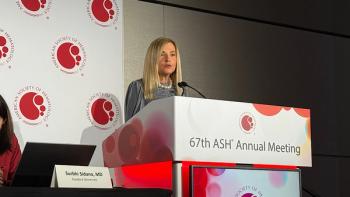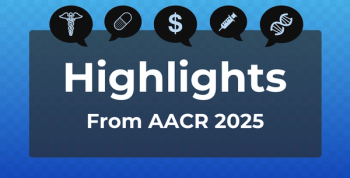
- July 2025
- Volume 31
- Issue Spec. No. 8
- Pages: SP486-SP488
Breaking Ground in Breast Cancer: A New Standard in TNBC, a New Way to Target ESR1
Key Takeaways
- Sacituzumab govitecan combined with pembrolizumab improved progression-free survival in PD-L1–positive metastatic triple-negative breast cancer compared with chemotherapy.
- Vepdegestrant, a PROTAC estrogen receptor (ER) degrader, showed a progression-free survival advantage in ESR1-mutated ER+/HER2– breast cancer over fulvestrant.
Studies presented at ASCO reveal promising treatments for triple-negative and ER-positive breast cancer, highlighting the benefits of sacituzumab govitecan and vepdegestrant.
Two phase 3 studies presented Saturday at the
Sacituzumab govitecan (Trodelvy; Gilead) known to help some patients previously treated for metastatic triple-negative breast cancer (TNBC), offered clear benefits for newly diagnosed patients with this invasive cancer who were PD-L1 positive when combined with pembrolizumab, a PD-1 inhibitor.
Results from the trial, ASCENT-04/KEYNOTE-D19, showed 35% improvement in progression-free survival (PFS) when using this combination instead of a PD-1 and chemotherapy, the current standard of care (HR, 0.65; CI 95% 0.51-0.84; P = .0009).1
This type of breast cancer has limited treatment options; it is called “triple negative” because it lack receptors for estrogen, progesterone, and the HER2 protein that could be targeted with therapy.
The ASCENT-04 trial follows the success of, an antibody-drug conjugate (ADC), in treating patients who have received prior therapy for TNBC.
“There’s been much interest in trying to combine antibody-drug conjugates with checkpoint inhibition, given robust preclinical and clinical data for the combination,” said Sara M. Tolaney, MD MPH, chief of the Division of Breast Oncology at Dana-Farber Cancer Institute, and associate professor at Harvard Medical School. Tolaney presented the results in a press briefing ahead of ASCO.
The second trial, VERITAC-2, involves vepdegestrant (Arvinas/Pfizer), an oral PROTAC (proteolysis targeting chimera) estrogen receptor (ER) degrader, the first of a new class of therapy that works by breaking down estrogen receptors on cancer cells, thus halting growth of ER-positive (ER+) tumors or shrinking them. Erika P. Hamilton, MD, who is director of Breast Cancer and Gynecologic Cancer Research at Sarah Cannon Research Institute, presented results evaluating vepdegestrant against fulvestrant (Faslodex; AstraZeneca), an injected selective estrogen receptor degrader (SERD), in women with ER+/HER2-negative (HER2–) breast cancer.
Results for VERITAC-2 were published Saturday in the New England Journal of Medicine.3
Although vepdegestrant did not produce significant benefits in the overall study population, it did show a benefit for those patients with ESR1-mutated cancer.
In their paper, the NEJM authors explained that after patients receive standard firstline therapies, including therapy in combination with cyclin-dependent kinase 4 and 6 (CDK4/6) inhibitors, most patients develop treatment resistance, which "is often driven by genetic mutations, including those in ESR1, which occur in approximately 40% to 50% of patients who receive endocrine therapy and a CDK4/6 inhibitor for metastatic disease."3
Before ASCO, Hamilton explained at a press briefing, “There’s no established consensus for patients getting treatment in the second line setting after progression on endocrine therapy and a CDK4/6 inhibitor." Fulvestrant is given by intramuscular injection. And, “in a post-CDK4/6 landscape, we know that progression-free survival is very short—on the order of less than 2 months.”
Thus, investigators are encouraged by results in VERITAC-2, which show a median PFS of 5.0 months for vegdepestrant vs 2.1 months for fulvestrant, in the ESR1-mutated population. This represents a PFS advantage of 43% (HR, 0.57; 95% CI 0.42–0.77; P = .0001).
Study authors say their findings support using vepdegestrant in patients previously treated for ESR1-mutated ER+/HER2– advanced breast cancer.
ASCENT-04 / KEYNOTE D-19
Tolaney highlighted the need for more options in TNBC, which accounts for 15% of all breast cancers; about 40% of TNBC cancers are PD-L1 positive.
“The median progression-free survival observed in prior studies that have looked at the combination of chemotherapy and checkpoint inhibition in the first-line setting for PD-L1 positive, metastatic triple negative disease ranges between 7 and 9 months,” she said.
ASCENT-04 randomized 443 patients, with 221 taking the sacituzumab govitecan plus pembrolizumab combination and 222 taking chemotherapy plus pembrolizumab. Among the study’s findings1:
- Median PFS was 11.2 months (9.3-16.7) for the sacituzumab govitecan arm and 7.8 months (7.3-9.3) for the chemotherapy arm.
- Overall response rate (ORR) was 59.7% for sacituzumab govitecan and 53.2 for chemotherapy; and median duration of response (DOR) was 16.5 months vs 9.2 months, respectively.
- Overall survival (OS) data are not mature but the trend favored the sacituzumab govitecan arm.
- Safety findings showed treatment-emergent adverse events (TEAEs) were seen in 99% of both arms; in the sacituzumab govitecan arm, 71% had events that were grade 3 or higher, compared with 70% in the chemotherapy arm.
- Both dose reductions (35 % vs 44%) and treatment discontinuations (12% vs 31%) were lower in the sacituzumab govitecan arm.
ASCO commenter Jane Lowe Meisel, MD, professor in the Department of Hematology and Medical Oncology at Emory University School of Medicine, said in the press briefing she believe these results were “potentially practice changing.”
She noted that physicians were already familiar with both therapies in the combination, and no new toxicities were reported.
“We’ve seen in previous studies how sacituzumab govitecan can work so well for patients with metastatic triple negative breast cancer later in their treatment,” Meisel said. “And now, to see this combined withpembrolizumab with both statistically and clinically meaningful benefits for patients, I think really does change the game for this subgroup.”
VERITAC-2
This trial was emblematic of the rising importance of biomarker testing in cancer care, a theme seen across ASCO 2025. PROTACs are often compared with SERDs, which enable ER degration thorugh proteasome-mediated proteolysis and by passively destabilizing the receptor. PROTACs
To enroll, patients had to have ER+/HER2– advanced breast cancer with 1 prior line of a CDK4/6 inhibitor plus endocrine therapy, and at least 1 additional line of endocrine therapy for at least 6 months before disease progression. Patients treated previously with chemotherapy in the advanced setting or prior fulvestrant were excluded.
The study’s 624 patients were randomized 1:1 to receive 200 mg of vepdegestrant once daily or 500 mg fulvestrant 500 mg intramuscularly, on a schedule of every 14 days the first month and once month after that. The study participants were stratified by ESR1 status and visceral disease. The vepdegrestrant arm had 313 patients and the fulvestrant arm had 311; 43% had ESR1-mutated tumors, with 136 in the vepdegestrant arm and 134 taking fulvestrant.
With OS data not mature, Meisel commented, “There's a lot of exciting things happening in this space, and so seeing what the overall survival analysis shows will be interesting,” as it will allow comparisons with other options.
In addition to PFS results, the study found the following among all patients:
- In 619 treated patients, TEAEs were mostly grade 1/2. Grade 3 or higher TEAEs were seen in 23.4% of patients in the vepdegestrant arm vs 17.6% in the fulvestrant arm.
- The most common TEAEs in the vepdegestrant arm were fatigue (26.6% vs 15.6% in the fulvestrant) arm.
- Increased alanine transaminase 14.4% vs 9.8%) and increased aspartate aminotransferase (14.4% vs 10.4%), which can indicate liver damage, were higher in the vepdegestrant arm, as was nausea (13.5% vs 8.8%).
- TEAEs led to discontinuation in 2.9% of the vepdegestrant arm vs 0.7% in the fulvestrant arm.
“We always use caution when describing a drug as well tolerated to patients,” Hamilton said; however, she saw limited treatment discontinuations and dose reductions as favorable.
“These results support vepdegestrant as a potential monotherapy treatment option for patients with previously treated ESR1-mutant, ER+/HER2– advanced breast cancer.”
During Saturday's session, discussant William Grandishar, MD, of Northwestern University's Feinberg School of Medicine, said that PROTACs are being studied in diseases beyond breast cancer. Vepdegestrant performs better than the current standard of care for its targeted population, but he said there remain unanswered questions.
"Here is a reality check. When you look at the development plans of these drugs, they're not probably going to be given as monotherapy. Almost every one of these drugs is being developed with other targeted therapies," Grandishar said. Among the unknowns, he said, "If we have a number of these drugs that become available, how are we going to use them? Can they be used in sequence? And is there a logical sequence that should be used?"
References
- Tolaney SM, de Azambuja E, Kalinsky K, et al. Sacituzumab govitecan (SG) + pembrolizumab (pembro) vs chemotherapy (chemo) + pembro in previously untreated PD-L1 positive advanced triple-negative breast cancer (TNBC): primary results from the randomized phase 3 ASCENT-04/KEYNOTE-D19 study. J Clin Oncol. 2025;43(suppl 17): Abstract LBA109. doi:10.1200/JCO.2025.43.17_suppl.LBA109
- Hamilton EP, De Laurentiis, M, Jhaveri KL, et al. Vepdegestrant, a PROTAC estrogen receptor (ER) degrader, vs fulvestrant in ER-positive/human epidermal growth factor receptor 2 (HER2)–negative advanced breast cancer: results of the global, randomized, phase 3 VERITAC-2 study. J Clin Oncol. 2025;43(suppl 17): Abstract LBA1000. doi:10.1200/JCO.2025.43.17_suppl.LBA1000
- Campone M, De Laurentiis M, Jhaveri K, et al. Vepdegestrant, a PROTAC estrogen receptor degrader, in advanced breast cancer. N Engl J Med. Published online May 31, 2025. doi: 10.1056/NEJMoa2505725
Articles in this issue
Newsletter
Stay ahead of policy, cost, and value—subscribe to AJMC for expert insights at the intersection of clinical care and health economics.








































